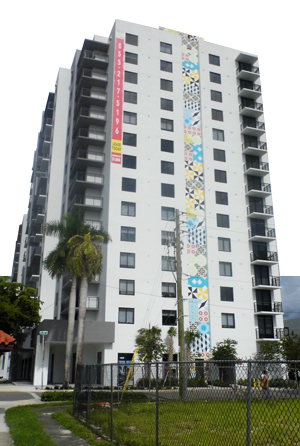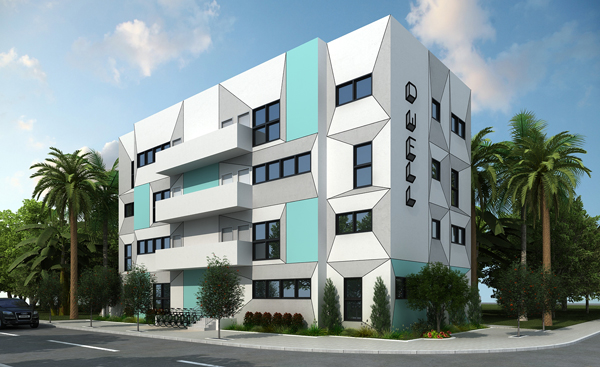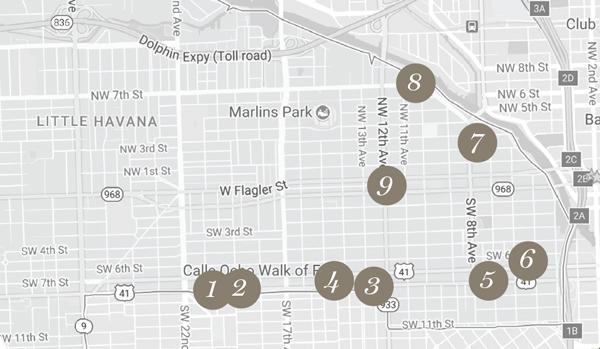From the fall issue: Little Havana has a special place in the hearts of Bill Fuller and Martin Pinilla.
The two are the co-founders of the Barlington Group, a company that invests in real estate and small businesses throughout Miami — but it’s in Little Havana where they own stakes in 40 retail, residential and hotel buildings. Of those properties, 23 can be found along Southwest 8th Street, also known as Calle Ocho, the main street of Little Havana. It’s here that Fuller and Pinilla have renovated several old properties and attracted — and sometimes helped start — small, trendy businesses such as Union Beer Store, Velvet Creme Doughnuts, Azucar Ice Cream Company, Ella’s Oyster Bar and the Ball & Chain nightclub.
The two men run their empire from a two-story building at 1637 Southwest 8th Street called Futurama. First built as an auto parts store in the 1940s, it has housed 12 artists’ studios and the Barlington Group’s offices since 2011. The Futurama moniker came from a furniture store that once operated on Calle Ocho. “We thought it was appropriate,” Fuller said of the name. It seems fitting, as it celebrates Little Havana’s past and reflects the optimistic outlook Fuller and Pinilla have for the future of an area they’ve been investing in since 2002.
“We’re long-term bullish,” Fuller said.
And they aren’t alone. Several developers and investors are increasingly seeing opportunity in Little Havana — an area roughly bordered by the Miami River, I-95, Southwest 17th Avenue, Southwest 9th Street and Northwest 27th Avenue — which was settled by Cuban refugees in the 1960s.
These developers are especially interested in the eastern section, an area adjacent to the bustling Downtown and Brickell neighborhoods. It’s here that many young millennials who can’t afford to live in the Downtown area are settling, they said.
But don’t expect a building boom overnight. Even though many say Little Havana is poised to draw oodles of young professional residents, some developers complain that the city’s zoning regulations hamper the construction of new affordable apartments on small lots that have been vacant for decades.
One of those frustrated builders is Andrew Frey, founder of Tecela Real Estate Innovation. “I’m a big fan of Little Havana because it’s the most complete urban neighborhood we have in South Florida,” said Frey, who is currently constructing a three-story, eight-unit apartment building at Northwest 7th Avenue and 1st Street.
While he’d like to build more small infill apartment buildings in the area, Frey said the city’s Miami 21 zoning code, which was passed in 2010, makes it impossible to construct more units on lots that are zoned for three- and four-story buildings. A lot zoned T4 allows only four units in a building three stories tall, Frey explained. A T5 zoned parcel allows for only seven units in a four-story building. That’s less density than the small apartments that were constructed decades earlier, he said
The 5,000-square-foot lot where Frey is building his eight-unit apartment building is zoned T6-8, in which a builder can construct 150 units per acre in structures up to 12 stories tall. Although Frey could have built a mid-rise with 17 luxury units, he said he wanted to create a small building with moderately priced apartments.
According to Zumper, a website that tracks rental rates and listings across the U.S., the median monthly rent in Miami is $1,800 as of August, making it the country’s ninth most expensive city to rent in. But within East Little Havana, the median monthly rent was just $1,500. In West Little Havana, the median monthly rent was $1,460.

Astor Companies sold the two 15-story towers of InTown, at 1900 Southwest 8th Street, to Greystar last year for $89 million.
Carlos Fausto Miranda, a property owner, developer and real estate broker who runs Fausto Commercial Realty, said there is such a shortage of affordable apartments in or near Miami that Little Havana’s cheap rentals are almost full.
“Vacancy rates for residential rentals in Little Havana are currently under 2 percent. That is disproportionately low, meaning that tenants have little if any options as to where to go, and thus landlords are fairly at liberty to keep raising rents,” Miranda wrote in an email to The Real Deal. “Without a surge of new construction, there is no way to alleviate this upward pressure on rents.”
Two years ago, the city of Miami considered upzoning East Little Havana’s T4 zoned properties to T5 within a 32-block area just north of Northwest 7th Street, south of Southwest 1st Street, east of Southwest 12th Avenue and west of the river. That effort created a backlash from historians and residents who feared that the zoning change would encourage developers to demolish architecturally significant houses and duplexes.
“Twenty-five percent of the buildings in Little Havana…were built prior to World War II,” explained Tony Garcia, a principal of the Street Plans Collective and a member of the Dade Heritage Trust.
After several months of debate, the rezoning proposal was withdrawn last January. The Planning & Zoning Department was also asked to study the area along Southwest 7th Street “for possible changes in the future,” said Luciana Gonzalez, assistant director of Miami’s Planning & Zoning Department. However, Gonzalez said, “that work has not commenced and does not have a timeline.”
Miranda said the city’s decision to back off from rezoning a chunk of East Little Havana was “incredibly shortsighted.”
But there is some progress. Juan Mullerat, founder of Coconut Grove-based architectural and urban design firm Plusurbia, is drafting a Little Havana master plan on behalf of the National Trust for Historic Preservation, which will encourage new development while preserving the neighborhood’s character.
Mullerat, a Little Havana resident, was critical of the city’s previous effort to rezone much of East Little Havana, as well as the city’s tendency to rezone properties at the request of landowners and developers — a practice he called “spot upzoning.”
A master plan could protect Little Havana and help spur development, he said. “Our goal is to incentivize new development that conforms to the existing building form of Little Havana, specifically the historic 1920s buildings,” Mullerat said. That can be accomplished by tweaking the area’s parking and density regulations, he said.
Mullerat, who also had a hand in drafting Wynwood’s master plan, hopes to have a draft of the master plan done by October.
Meanwhile, the upward pressure on rents, especially in the East Little Havana area, has encouraged investors to buy up small apartment buildings in the area, said Tomas Sulichin, a realtor associate at the commercial brokerage Rotsztain & Sulichin. That, in turn, pushed up the price for apartment buildings. Three years ago, the pricing for an apartment building averaged $80,000 a unit in East Little Havana. In the past year, the average per door in that area was $125,000, Sulichin said.
Most parcels with modest apartments are zoned T4 and T5, but the land along Calle Ocho is already zoned at a high-rise friendly T6-8. Three years ago, land along this street traded for $100 a square foot, Miranda said. Now, Miranda closes transactions that can range from $140 to $150 per square foot in West Little Havana and as high as $200 per square foot in East Little Havana.
In the western area of Little Havana, Miranda brokered the sale of a 20,250-square-foot lot for $147 per square foot. That property, at 2055 Southwest 8th Street, has a 7,300-square-foot retail center. It was bought by developer David Lombardi, founder of Lombardi Properties, for $3.1 million this past May. Here, Lombardi could build a 12-story tower with 69 residential units.
But Lombardi is more interested in repositioning the property to attract hip retailers for the younger demographic that’s moving in, he told TRD.
“We think that the current tenancy around Calle Ocho doesn’t speak to the changing demographic of young people that’s moving in there,” he said. “We want to change the mix and create some value.”
Although retail rental prices range from $20 to $25 per square foot in most parts of Little Havana, Lombardi said he is confident they’ll “creep up” to $30 and $40 once he refurbishes the space.
While Lombardi and others welcome this evolution of the neighborhood, Brickell-based real estate investor Arturo Ortega, manager of the Tierra Nueva Group, said he’s planning on building two apartment buildings in East Little Havana precisely because it isn’t Brickell.
“There are many businesses that are able to thrive in Little Havana that would never make it in Brickell,” Ortega explained in an email to TRD. “Little Havana offers these local businesses an opportunity because of a strong sense of community within the area. From supermarkets that cater to the tastes of Hispanics and Latinos to art galleries, bookstores, cigar stores, restaurants, and bars that cannot be found in Brickell.”
Pinilla of Barlington Group agreed. “[Little Havana] is more like Miami’s Brooklyn. It’s smaller scale. It’s quaint.”
And in Little Havana, change happens at a slower place, Pinilla added. That’s not just due to the zoning. Many of the properties in the area have been owned for decades by people who fled Cuba in the 1960s with cash they had on hand. Those Cuban-American landowners are reluctant to sell to just anybody.
“I can tell you that a lot of the buildings that we bought, the families owned them for 30 or 40 years,” Pinilla said. “We spent a significant amount of time building a relationship with them and letting them know that it’s going to transfer into good hands.”
Prominent projects in Little Havana
1. 2055 Southwest 8th Street
In May, this 7,300-square-foot retail property was purchased for $3.1 million by a team of real estate investors led by Wynwood developer David Lombardi. Plans have not been announced.
2. 1900 Southwest 8th Street
This is where InTown, a pair of 15-story apartment buildings with 312 units, was completed last year. Originally conceived as a condo by the Astor Companies, InTown was sold to Greystar for $89 million last November. Rents range from $1,600 to $2,700 a month.
3. 1357 Southwest 8th Street
Arturo Ortega is working on the design for a 160-unit apartment building at this location. Ortega paid $4.3 million for the vacant 39,015-square-foot property in March 2014. About 19,000 square feet of the land is zoned T6-8, where an 12-story building could be constructed. The rest is zoned T5, where the height is capped at five stories.
4. 1450 Southwest 7th Street
The Tower Hotel has stood here since 1920. It’s now being renovated by the Barlington Group into a “hybrid hotel and hostel,” as co-developer Bill Fuller described it. Construction is expected to be finished between April and June of 2018.
5. 550 Southwest 7th Street
It’s here that developer Arturo Ortega wants to knock down an existing 61-year-old, one-story apartment building and construct a new rental building with 51 units. He intends to offer such amenities as a spa, gym, concierge, dog-grooming facility and steam room. Ortega bought the building and the 7,500-square-foot lot it stands on for $1.7 million in June.
6. 475 Southwest 7th Street
Carlos Fausto Miranda plans to build Dwell 475, a four-story, 22-unit apartment building with a co-working space on the ground floor here. Miranda said the building will be “geared toward millennials who make between $35,000 and $75,000 a year.” Construction work on Dwell 475 should begin this fall and be completed within nine months, Miranda said.
7. 769 Northwest 1st Street
This is where Andrew Frey is building a three-story, eight-unit apartment building. Frey paid $200,000 for the vacant lot in November 2015. The developer said rents will range from $1,500 to $2,400 a month.
8. 1000 Northwest 7th Street
J. Milton and Associates wants to build a 12-story, 138-unit building called Reflections Apartments at this address. Reflections’ design, created by Anxioma3, was approved by the Urban Design Review Board in May. The next stage is final approvals from the Planning & Zoning Department. After that, the project heads to the permitting phase. Developer Joseph Milton bought the 1.2-acre site Reflections will be built on for $3.5 million back in 2014.
9. 101 Southwest 12th Avenue
Juanito’s Esquina de Tejas, a restaurant that President Ronald Reagan once visited, used to operate in the 11,130-square-foot building that stands here. Northeast U.S. investors David Malkin and Sharon Strassfield bought it for $1.7 million in May. Carlos Fausto Miranda, who brokered the sale, said the buyers intend to redevelop the property and hope to attract national retail tenants for the bottom floor and create a parking garage on the second floor.

